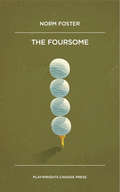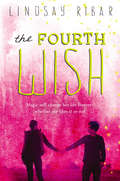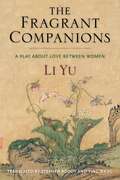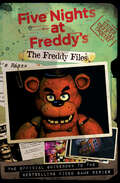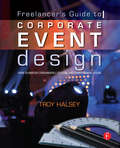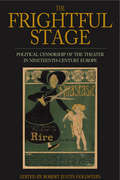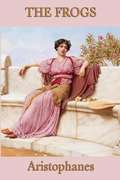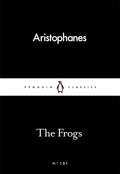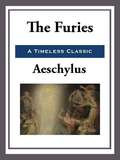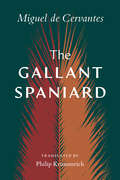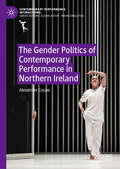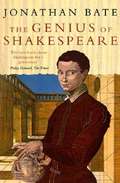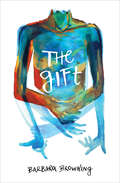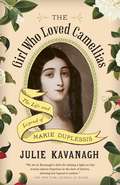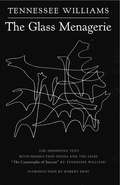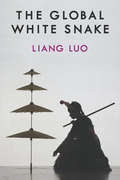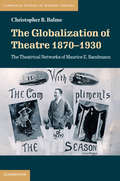- Table View
- List View
The Four of Us: A Play
by Itamar MosesFrom the author of Bach at Leipzig (Faber, 2005) comes a play about loyalty, integrity, and the price of success. When Benjamin's first novel vaults him into literary stardom, his friend David, a struggling playwright, is thrilled for his newfound success . . . or is he? Should Benjamin help David by using his new connections? Can David even expect such favors from his friend? More importantly, who should pick up the tab at lunch? Hailed as a writer who "makes the kinds of stylistic gambles that should be applauded" (Eric Grode, The New York Sun), Itamar Moses proves once again with this inventive exploration of the evershifting ground of friendship that he is a playwright to watch. The Four of Us had its off-Broadway premiere in March 2008 at Manhattan Theatre Club."Clever [and] smart…[The Four of Us] suggests that Moses will be displaying a big range as his career unfolds."--The San Diego Union-Tribune
The Foursome
by Norm FosterRick, Ted, Donnie, and Cameron are home for their fifteen-year college reunion; a great time to go out for a game of golf and catch up on each other’s lives. Unlike their college days, the conversation doesn’t include talk of beer and final exams, but of colonoscopies, home-security systems, alcoholism, Buddhism, and more.
The Fourth Wish
by Lindsay RibarHere's what Margo McKenna knows about genies: She's seen Aladdin more times than she can count; she's found a magic genie ring and made her three allotted wishes; she's even fallen head over heels in love with Oliver, the cute genie whose life she saved by fighting off another genie. But none of this prepared her for the shock of becoming a genie herself. Everything Margo's taken for granted--graduating high school, going to college, hating math, performing in the school musical, even being a girl--is in question. Just at a time when she's trying to figure out who she wants to be, Margo is forced to become whomever her master wants. But Margo is also coming into a power she never imagined she'd have. How will she reconcile the two? And where will she and Oliver stand when she's done? Fans of Every Day and Anna and the French Kiss will love this romantic, magical, and surprising conclusion to The Art of Wishing.
The Fragility of Goodness: Luck and Ethics in Greek Tragedy and Philosophy
by Martha C. NussbaumThis book is a study of ancient views about "moral luck. " It examines the fundamental ethical problem that many of the valued constituents of a well-lived life are vulnerable to factors outside a person's control, and asks how this affects our appraisal of persons and their lives. The Greeks made a profound contribution to these questions, yet neither the problems nor the Greek views of them have received the attention they deserve. This updated edition contains a new preface.
The Fragrant Companions: A Play About Love Between Women (Translations from the Asian Classics)
by Li YuTwo young gentry women meet by chance at a nunnery in Yangzhou, where they fall in love at first sight. After they exchange poetry and recognize each other’s literary talents, their emotional bond deepens. They conduct a mock wedding ceremony at the nunnery and hatch a plan to spend the rest of their lives together. Their schemes are stymied by a series of obstacles, but in the end the two women find an unlikely resolution—a ménage-à-trois marriage.The Fragrant Companions is the most significant work of literature that portrays female same-sex love in the entire premodern Chinese tradition. Written in 1651 by Li Yu, one of the most inventive and irreverent literary figures of seventeenth-century China, this play is at once an unconventional romantic comedy, a barbed satire, and a sympathetic portrayal of love between women. It offers a sensitive portrait of the two women’s passion for each other, depicts their intellectual pursuits and resourcefulness, and celebrates their partial triumph over social convention. At the same time, Li caustically mocks the imperial examination system and deflates the idealized image of the male scholar.The Fragrant Companions is both an indispensable source for students and scholars of gender and sexuality in premodern China and a compelling work of literature for all readers interested in China’s rich theatrical traditions.
The Freddy Files (Five Nights At Freddy's Ser.)
by Scholastic Scott CawthonDon't miss the first official guide to the world of the bestselling horror video game series, Five Nights at Freddy's, including easter eggs, gameplay tips, and the most hotly-debated fan theories.In the first official guidebook to Five Night at Freddy's, fans and gamers alike can immerse themselves in the series' mythology, gameplay, and secrets as we unwind the twisted mysteries hidden at the heart of Freddy Fazbear's Pizza. Delving into each game, players can map the animatronics' paths, learn how timed elements of the games work, and discover how to trigger unique events. Special sections throughout highlight Freddy's fans' most talked-about theories, from The Bite of '87 vs. The Bite of '83 to the identity of Purple Guy to the recurring hallucinations of "it's me." All the evidence, along with every detail of the games and novels, is laid out for fans to explore in this one-of-a-kind guide to the warped world of Five Nights at Freddy's.
The Freelancer's Guide to Corporate Event Design: From Technology Fundamentals To Scenic And Environmental Design
by Troy HalseyFreelancer's Guide to Corporate Theatre and Event Production (tentative title) will bring you up to speed on the ever changing and growing industry of Corporate Theatre. Written by one of the industry's leading designers, this book uses a candid and straight-forward style to guide you through the process of designing a successful event. Learn the fundamentals of venue selection, rigging, lighting, audio, video, and scenic design with informative diagrams and detailed illustrations. With the help of this book you will learn how to plan, design, and execute events of any size. Additionally, you will be armed with a strong knowledge of common mistakes, tips and tricks, and industry standards that will allow you to build and train a production team prepared for just about anything.
The French New Wave: A New Look (Shortcuts)
by Naomi GreeneThe French New Wave was perhaps the biggest —and briefest —explosion in the history of world cinema, with over one hundred French directors shooting debut features between 1958 and 1964. Its aftershocks are still being felt today. Through the work of such directors as Jean-Luc Godard and Franois Truffaut, filmmakers came to be seen as outstanding artists rather than mere studio technicians, paving the way for contemporary cinematic auteurs such as Martin Scorsese, Pedro Almodovar, and Luc Besson. This volume begins by tracing the social and cultural changes of post-war France that gave birth to the New Wave, then examines in detail the careers of artists like Alain Renais and Jean-Luc Godard. "The French New Wave: A New Look" is a concise and accessible account of a crucial movement in film history.
The Frightful Stage
by Robert Justin GoldsteinIn nineteenth-century Europe the ruling elites viewed the theater as a form of communication which had enormous importance. The theater provided the most significant form of mass entertainment and was the only arena aside from the church in which regular mass gatherings were possible. Therefore, drama censorship occupied a great deal of the ruling class's time and energy, with a particularly focus on proposed scripts that potentially threatened the existing political, legal, and social order. This volume provides the first comprehensive examination of nineteenth-century political theater censorship at a time, in the aftermath of the French Revolution, when the European population was becoming increasingly politically active.
The Frogs
by AristophanesVisiting the underworld, the god Dionysus seeks the counsel of the dead tragedians Aeschylus and Euripides on how to bring good writing back to Athens. A fierce debate - full of scathing insults and literary satire - ensues between the two dramatists.
The Frogs (Penguin Little Black Classics)
by Aristophanes'Ko-ax, ko-ax, ko-ax!Now listen, you musical twerps,I don't give a damn for your burps!'A biting comedy from the great Ancient Greek playwright.One of 46 new books in the bestselling Little Black Classics series, to celebrate the first ever Penguin Classic in 1946. Each book gives readers a taste of the Classics' huge range and diversity, with works from around the world and across the centuries - including fables, decadence, heartbreak, tall tales, satire, ghosts, battles and elephants.
The Furies
by AeschylusThis classic trilogy by the great tragedian deals with the bloody history of the House of Atreus. Grand in style, rich in diction and dramatic dialogue, the plays embody Aeschylus' concerns with the destiny and fate of both individuals and the state, all played out under the watchful eye of the gods.
The Future of Ritual: Writings on Culture and Performance
by Richard SchechnerIn The Future of Ritual, Richard Schechner explores the nature of ritualised behaviour and its relationship to performance and politics. A brilliant and uncontainable examination of cultural expression and communal action, The Future of Ritual asks pertinent questions about art, theatre and the changing meaning of 'culture' in today's intercultural world. An exciting new work by the author of Performance Theory.
The Gallant Spaniard
by Miguel de CervantesThere are surprising omissions in the translated body of Spanish Golden Age literature, including in the corpus of Miguel de Cervantes. We have many highly competent translations of Don Quixote, but until now not a single English version of his play The Gallant Spaniard. Although Cervantes&’s dramatic works have always attracted less attention than his narrative fiction, there has been significant critical interest in this play in recent years, due in no small part to its unique portrayal of Christian-Muslim relations. Critics have argued persuasively about the value of The Gallant Spaniard in the service of a more general understanding of Cervantes in his last years, specifically in regard to his views on this cultural divide. This edition, translated by Philip Krummrich, consists of a critical introduction and a full verse translation of the play with notes.
The Garotters
by William Dean HowellsWilliam Dean Howells (1837-1920) was an American realist author and literary critic. He wrote his first novel, Their Wedding Journey, in 1871, but his literary reputation really took off with the realist novel A Modern Instance, published in 1882, which describes the decay of a marriage. His 1885 novel The Rise of Silas Lapham is perhaps his best known, describing the rise and fall of an American entrepreneur in the paint business. His social views were also strongly reflected in the novels Annie Kilburn (1888) and A Hazard of New Fortunes (1890). While known primarily as a novelist, his short story "Editha" (1905) - included in the collection Between the Dark and the Daylight (1907) - appears in many anthologies of American literature. Howells also wrote plays, criticism, and essays about contemporary literary figures such as Ibsen, Zola, Verga, and, especially, Tolstoy, which helped establish their reputations in the United States. He also wrote critically in support of many American writers. It is perhaps in this role that he had his greatest influence.
The Gender Politics of Contemporary Performance in Northern Ireland (Contemporary Performance InterActions)
by Alexander CoupeThis book examines theatre and performance produced since the 1998 Belfast/Good Friday Agreement in the context of growing discontent with the failure of the peace in Northern Ireland to deliver genuinely transformative forms of social justice. The economic expansion that attended the peace accord propelled the growth of the region’s theatre and performance sector and assisted in increasing the representation of women and LGBTQ+ people across the arts. Despite this, much of the performance work produced since 1998 has illuminated the darker social consequences of Northern Ireland’s embrace of a specifically neoliberal vision of a ‘post-conflict’ society. Existing scholarship has already highlighted the role of theatre and performance in drawing attention to the misogyny and homophobia that has underwritten political antagonism in the North since partition. Instead, this book offers a sustained examination of contemporary performance makers that have engaged specifically with the reconstruction of gender norms amidst the region’s political and economic transformation. The story it tells is of an emerging current in theatre, performance art, and dance consisting of work concerned not only with uncovering the morbid symptoms of the neoliberal peace but also embodying those messy and everyday conditions of co-dependency, vulnerability and solidarity that both patriarchal nationalisms and androcentric individualism seek to deny.
The Genius of Shakespeare
by Jonathan BateThis fascinating book by one of Britain's most acclaimed young Shakespeare scholars explores the extraordinary staying-power of Shakespeare's work. Bate opens by taking up questions of authorship, asking, for example, Who was Shakespeare, based on the little documentary evidence we have? Which works really are attributable to him? And how extensive was the influence of Christopher Marlowe? Bate goes on to trace Shakespeare's canonization and near-deification, examining not only the uniqueness of his status among English-speaking readers but also his effect on literate cultures across the globe. Ambitious, wide-ranging, and historically rich, this book shapes a provocative inquiry into the nature of genius as it ponders the legacy of a talent unequaled in English letters. A bold and meticulous work of scholarship, The Genius of Shakespeare is also lively and accessibly written and will appeal to any reader who has marveled at the Bard and the enduring power of his work.
The Gentleman Clothier
by Norm FosterExperienced tailor Norman Davenport has barely opened the doors to his new clothing store in downtown Halifax when Sophie, an exuberant young woman, barges in looking for work, followed by Patrick, a single father who claims to be handy. Hesitantly Norman hires them both to tie up the last few threads before the grand opening. And whether Norman realizes it or not, he needs help getting into the twenty-first century to cater to the current tastes of his customers. When the shop’s first customer, Alisha Sparrow, a friendly, attractive woman, drops in looking for a suit for her husband, Norman is smitten against his better judgment. His sensible, modest world has become profoundly complicated in less than a week, and Norman longs to live in a simpler time. Unfortunately for him, his life is about to get messier as he wakes to find things are not what they used to be.
The Gift (Emily Bks.)
by Barbara BrowningIn the midst of Occupy, Barbara Andersen begins spamming people indiscriminately with ukulele covers of sentimental songs. A series of inappropriate intimacies ensued, including an erotically charged correspondence and then collaboration with an extraordinarily gifted and troubled musician living in Germany.
The Gift Of the Magi
by Peter EkstromTwo heart-warming one-act musicals based on the classic O. Henry stories capture the true spirit of giving. ( The Gift of the Magi and The Last Leaf ) This holiday favorite is set in turn-of-the-century New York City.
The Girl Who Loved Camellias: The Life and Legend of Marie Duplessis
by Julie KavanaghFrom the author of Nureyev, the definitive biography of the celebrated Russian dancer, now comes the astonishing and unknown story of Marie Duplessis, the courtesan who inspired Alexandre Dumas fils's novel and play La dame aux camélias, Giuseppe Verdi's opera La Traviata, George Cukor's film Camille, and Frederick Ashton's ballet Marguerite and Armand. Sarah Bernhardt, Eleonora Duse, Greta Garbo, Isabelle Huppert, Maria Callas, Anna Netrebko, and Margot Fonteyn are just a few of the celebrated actors, singers, and dancers who have portrayed her. Drawing on new research, Julie Kavanagh brilliantly re-creates the short, intense, and passionate life of the tall, pale, slender girl who at thirteen fled her brute of a father and Normandy to go to Paris, where she would become one of the grand courtesans of the 1840s. France's national treasure, Alexandre Dumas père, was intrigued by her, his son became her lover, and Franz Liszt, too, fell under her spell. Quick to adapt an aristocratic mien, with elegant clothes, a coach, and a grand apartment, she entertained a salon of dandies, writers, and artists. Fascinating to both men and women, Marie, with her stylish outfits and signature camellias, was always a subject of great interest at the opera or at the Café de Paris, where she sat at the table of the director of the Paris Opéra, along with the director of the Théâtre Variétés, the infamous dancer Lola Montez, and others. Her early death at age twenty-three from tuberculosis created an outpouring of sympathy, noted by Charles Dickens, who wrote in February 1847: "For several days all questions political, artistic, commercial have been abandoned by the papers. Everything is erased in the face of an incident which is far more important, the romantic death of one of the glories of the demi-monde, the beautiful, the famous Marie Duplessis." With The Girl Who Loved Camellias, Kavanagh has written a compelling and poignant life of a nineteenth-century muse whose independent and modern spirit has timeless appeal.
The Girlfriend Act: Discover the swoony fake dating YA romance
by Safa Ahmed"Effortlessly charming and deeply moving, The Girlfriend Act has so much heart and humour" - Ann Liang, author of If You Could See The SunAspiring actress Farah Sheikh is tired of being in the background.Ex-child star Zayan Amin needs a break from the spotlight.And after a disastrous audition where she's told she doesn't "fit the aesthetic" for her university's play, Farah meets The Tragedies. A group of West London theatre kids rejected from the stage for similarly dubious reasons.Together, Farah and The Tragedies find themselves in the limelight and get the chance to perform. But, there's a catch. Recently disgraced child star, Zayan, will be involved.The deal: Zayan regains popularity via the publicity of his new romance, and in exchange, he'll star in (and more importantly, fund) a play for The Tragedies.Can Farah uphold her side of the bargain, and prove her critics wrong?"A heartfelt celebration of the communities we are born into and the families we choose for ourselves. A stunning debut with an everlasting impact." - Ananya Devarajan, author of Kismat Connection
The Glass Menagerie: Curriculum Unit (New Directions Book Ser.)
by Tennessee Williams Robert BrayNo play in the modern theatre has so captured the imagination and heart of the American public as Tennessee Williams's The Glass Menagerie. <P><P>Menagerie was Williams's first popular success and launched the brilliant, if somewhat controversial, career of our pre-eminent lyric playwright. <P>Since its premiere in Chicago in 1944, with the legendary Laurette Taylor in the role of Amanda, the play has been the bravura piece for great actresses from Jessica Tandy to Joanne Woodward, and is studied and performed in classrooms and theatres around the world. <P>The Glass Menagerie (in the reading text the author preferred) is now available only in its New Directions Paperbook edition. <P>A new introduction by prominent Williams scholar Robert Bray, editor of The Tennessee Williams Annual Review, reappraises the play more than half a century after it won the New York Drama Critics Circle Award: "More than fifty years after telling his story of a family whose lives form a triangle of quiet desperation, Williams's mellifluous voice still resonates deeply and universally." <P>This edition of The Glass Menagerie also includes Williams's essay on the impact of sudden fame on a struggling writer, "The Catastrophe of Success," as well as a short section of Williams's own "Production Notes." <P>The cover features the classic line drawing by Alvin Lustig, originally done for the 1949 New Directions edition.
The Global White Snake (China Understandings Today)
by Liang LuoThe Global White Snake examines the Chinese White Snake legends and their extensive, multidirectional travels within Asia and across the globe. Such travels across linguistic and cultural boundaries have generated distinctive traditions as the White Snake has been reinvented in the Chinese, Japanese, Korean, and English-speaking worlds, among others. Moreover, the inter-Asian voyages and global circulations of the White Snake legends have enabled them to become repositories of diverse and complex meanings for a great number of people, serving as reservoirs for polyphonic expressions ranging from the attempts to consolidate authoritarian power to the celebrations of minority rights and activism. The Global White Snake uncovers how the White Snake legend often acts as an unsettling narrative of radical tolerance for hybrid sexualities, loving across traditional boundaries, subverting authority, and valuing the strange and the uncanny. A timely mediation and reflection on our contemporary moment of continued struggle for minority rights and social justice, The Global White Snake revives the radical anti-authoritarian spirit slithering under the tales of monsters and demons, love and lust, and reminds us of the power of the fantastic and the fabulous in inspiring and empowering personal and social transformations.
The Globalization of Theatre 1870–1930: The Theatrical Networks of Maurice E. Bandmann (Cambridge Studies in Modern Theatre)
by Christopher B. BalmeBetween 1895 and 1922 the Anglo-American actor and manager, Maurice E. Bandmann (1872–1922) created a theatrical circuit that extended from Gibraltar to Tokyo and included regular tours to the West Indies and South America. With headquarters in Calcutta and Cairo and companies listed on the Indian stock exchange, his operations represent a significant shift towards the globalization of theatre. This study focuses on seven key areas: family networks; the business of theatrical touring; the politics of locality; repertoire and publics; an ethnography of itinerant acting; legal disputes and the provision of theatrical infrastructure. It draws on global and transnational history, network theory and analysis as well as in-depth archival research to provide a new approach to studying theatre in the age of empire.

